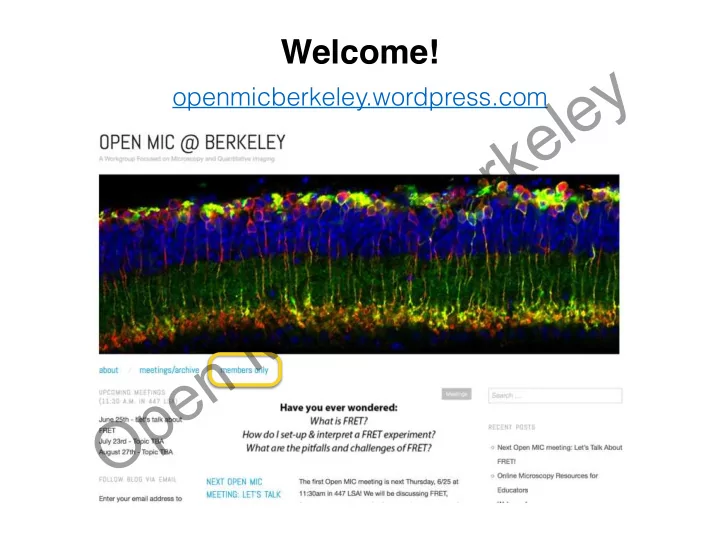

Welcome! Open MIC @ Berkeley openmicberkeley.wordpress.com
Open MIC @ Berkeley Agenda • Jen Lee: Introduction to FRET • Marla Feller: Using FRET sensors to look at time resolved measurements • Becky Lamason: Using FRET to determine if a bacterial protein manipulates cell-cell junctional tension
Open MIC @ Berkeley What is FRET? Förster Resonance Energy Transfer 1946-1948, Theodor Förster Defined as: non-radiative, dipole-dipole resonance energy transfer
Open MIC @ Berkeley What is FRET? Förster Resonance Energy Transfer Defined as: non-radiative, dipole-dipole resonance energy transfer i.e., no emission of a photon http://nikon2.magnet.fsu.edu/articles/fluorescence/fret/fretintro.html
Open MIC @ Berkeley What is FRET? Förster Resonance Energy Transfer Defined as: non-radiative, dipole-dipole resonance energy transfer Ishikawa-Ankerhold, et. al., Molecules 2012, 17(4)
Open MIC @ Berkeley What is FRET? Förster Resonance Energy Transfer Defined as: non-radiative, dipole-dipole resonance energy transfer http://ascensionglossary.com/index.php/Law_of_Resonance
Open MIC @ Berkeley What is FRET? Förster Resonance Energy Transfer Defined as: non-radiative, dipole-dipole resonance energy transfer http://mlilm.iqfr.csic.es/materiales_laser_ing/index_ing.html
Open MIC @ Berkeley Why FRET? • “To detect interaction by spatial coincidence of molecules” - Philippe Bastiaens (iBiology) • Molecular interactions within 10 nm range, better resolution than traditional colocalization experiments • Allows for detection of dynamic events in vivo (biosensors)
Open MIC @ Berkeley FRET Biosensors http://zeiss-campus.magnet.fsu.edu/tutorials/spectralimaging/fretbiosensors/indexflash.html
Overlapping Spectra is Required Open MIC @ Berkeley for FRET, But Causes Bleedthrough
Open MIC @ Berkeley http://zeiss-campus.magnet.fsu.edu/articles/spectralimaging/spectralfret.html
Open MIC @ Berkeley FRET Efficiency distance between donor & acceptor (nm) Förster Radius k 2 = orientation of transition dipoles J(l) = overlap integral of emission spectra n = refractive index of medium Q D = quantum yield of donor
Open MIC @ Berkeley FRET Efficiency Ishikawa-Ankerhold, et. al., Molecules 2012, 17(4)
Quantifying FRET = Open MIC @ Berkeley “Apparent Efficiency” (E app ) E app = E ⍺ Donor-Acceptor Reaction FRET efficiency [DA]/[D total ] geometric conformation How many molecules distances & angles are in a complex? global parameter biologically relevant local parameter
Open MIC @ Berkeley How to Measure FRET • Sensitized Emission (Ratiometry) • Acceptor Photobleaching (Donor Dequenching) • Fluorescence Lifetime Imaging Microscopy (FLIM) • Spectral Imaging • Fluorescence Polarization Imaging (Anisotropy)
Measuring FRET: Sensitized Open MIC @ Berkeley Emission (Ratiometric Imaging) • Excite donor, then measure donor emission (DD) and acceptor emission (DA) • Take the ratio of [DA/DD] • For more quantitative measurements, one can correct for bleed through E app = DA DD DA DD
Measuring FRET: Sensitized Open MIC @ Berkeley Emission (Ratiometric Imaging) Wang, et. al., Molecular Imaging 12(2), 2013
Measuring FRET: Sensitized Open MIC @ Berkeley Emission (Ratiometric Imaging) • Pros: • Fast, good for live imaging • Easily implemented on standard scopes • Cons: • Very sensitive to noise • May require a lot of image processing (shade/flat- field correction, bleedthrough correction, background subtraction, image alignment, photobleaching correction)
Measuring FRET: Acceptor Open MIC @ Berkeley Photobleaching (Donor Dequenching) • Excite donor, look at donor emission (DD). If FRET is occurring, then donor should be quenched. • Ask: what is the donor intensity in the absence of the acceptor? • Bleach acceptor • Excite donor, then measure donor emission post-bleach (DD pb ). • Donor should unquench, resulting in higher intensity from no FRET. • E app = 1 - (DD/DD pb )
Measuring FRET: Acceptor Open MIC @ Berkeley Photobleaching (Donor Dequenching) Majoul, et. al., J Biotechnol . 2002;82(3).
Measuring FRET: Acceptor Open MIC @ Berkeley Photobleaching (Donor Dequenching) • Pros: • Easily implemented on standard scopes • No external calibration • Robust, reliable, and semi-quantitative • Cons: • Fixed samples or one time point only
Measuring FRET: Fluorescence Open MIC @ Berkeley Lifetime Imaging Microscopy (FLIM) • Every fluorophore has an exponential decay curve, a.k.a. a fluorescence lifetime. When FRET occurs, the fluorescence lifetime of the donor decreases. • Process: excite donor, then measure donor lifetime (DD). If FRET, then there will be faster donor decay. http://nikon2.magnet.fsu.edu/articles/fluorescence/fret/fretintro.html
Measuring FRET: Fluorescence Open MIC @ Berkeley Lifetime Imaging Microscopy (FLIM) • Pros: • Direct measure of FRET efficiency • Independent of concentration • Acceptor doesn’t need to be imaged • Cons: • Specialized equipment required (we have one instrument at the MIC!)
Measuring FRET: Spectral Imaging Open MIC @ Berkeley • Every fluorophore has a unique emission spectra. • Spectral imaging uses an array of highly sensitive detectors to acquire intensities at specified wavelengths to plot out an emission spectra. Then, reference spectra are used to identify the fluorophore. • Similar approach to sensitized emission, but detection is more specific.
Measuring FRET: Spectral Imaging Open MIC @ Berkeley http://zeiss-campus.magnet.fsu.edu/articles/spectralimaging/spectralfret.html
Measuring FRET: Spectral Imaging Open MIC @ Berkeley • Pros: • Direct measure of FRET efficiency • Can correct for bleed through • Does not discard any signal (vs. sensitized emission) • Cons: • Specialized equipment required (we have many instruments at the MIC!) • Requires reference spectra, controls
Measuring FRET: Polarization Open MIC @ Berkeley Anisotropy https://www.microscopyu.com/articles/fluorescence/fret/fretintro.html
Measuring FRET: Polarization Open MIC @ Berkeley Anisotropy • Pros: • Independent of concentration • Relatively easy, inexpensive, and fast • Able to detect homo-FRET • Cons: • Not quantitative • Some common optical components destroy polarization (e.g., high NA objectives)
Open MIC @ Berkeley Summary • FRET is a very powerful method of detecting molecular interactions within 10 nm range. • No FRET approach is perfect. Goals, equipment, and experimental system must all be considered. • FRET pairs should be chosen with care.
Open MIC @ Berkeley For more info… • iBiology FRET lecture by Philippe Bastiaens • Nikon, Zeiss, & Olympus education pages (all written by Mike Davidson, Florida State University) • Cold Spring Harbor Quantitative Imaging Course ★ Links & slides will be available on the blog! openmicberkeley.wordpress.com
Recommend
More recommend